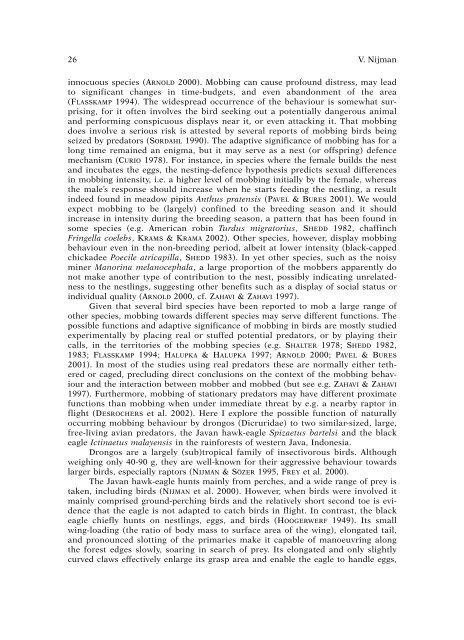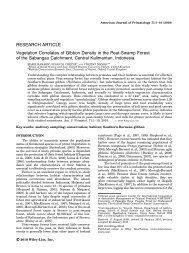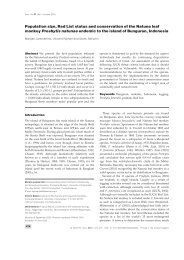Seasonal variation in naturally occurring mobbing ... - Vincent Nijman
Seasonal variation in naturally occurring mobbing ... - Vincent Nijman
Seasonal variation in naturally occurring mobbing ... - Vincent Nijman
Create successful ePaper yourself
Turn your PDF publications into a flip-book with our unique Google optimized e-Paper software.
26 V. <strong>Nijman</strong><br />
<strong>in</strong>nocuous species (ARNOLD 2000). Mobb<strong>in</strong>g can cause profound distress, may lead<br />
to significant changes <strong>in</strong> time-budgets, and even abandonment of the area<br />
(FLASSKAMP 1994). The widespread occurrence of the behaviour is somewhat surpris<strong>in</strong>g,<br />
for it often <strong>in</strong>volves the bird seek<strong>in</strong>g out a potentially dangerous animal<br />
and perform<strong>in</strong>g conspicuous displays near it, or even attack<strong>in</strong>g it. That mobb<strong>in</strong>g<br />
does <strong>in</strong>volve a serious risk is attested by several reports of mobb<strong>in</strong>g birds be<strong>in</strong>g<br />
seized by predators (SORDAHL 1990). The adaptive significance of mobb<strong>in</strong>g has for a<br />
long time rema<strong>in</strong>ed an enigma, but it may serve as a nest (or offspr<strong>in</strong>g) defence<br />
mechanism (CURIO 1978). For <strong>in</strong>stance, <strong>in</strong> species where the female builds the nest<br />
and <strong>in</strong>cubates the eggs, the nest<strong>in</strong>g-defence hypothesis predicts sexual differences<br />
<strong>in</strong> mobb<strong>in</strong>g <strong>in</strong>tensity, i.e. a higher level of mobb<strong>in</strong>g <strong>in</strong>itially by the female, whereas<br />
the male’s response should <strong>in</strong>crease when he starts feed<strong>in</strong>g the nestl<strong>in</strong>g, a result<br />
<strong>in</strong>deed found <strong>in</strong> meadow pipits Anthus pratensis (PAVEL & BURES 2001). We would<br />
expect mobb<strong>in</strong>g to be (largely) conf<strong>in</strong>ed to the breed<strong>in</strong>g season and it should<br />
<strong>in</strong>crease <strong>in</strong> <strong>in</strong>tensity dur<strong>in</strong>g the breed<strong>in</strong>g season, a pattern that has been found <strong>in</strong><br />
some species (e.g. American rob<strong>in</strong> Turdus migratorius, SHEDD 1982, chaff<strong>in</strong>ch<br />
Fr<strong>in</strong>gella coelebs, KRAMS & KRAMA 2002). Other species, however, display mobb<strong>in</strong>g<br />
behaviour even <strong>in</strong> the non-breed<strong>in</strong>g period, albeit at lower <strong>in</strong>tensity (black-capped<br />
chickadee Poecile atricapilla, SHEDD 1983). In yet other species, such as the noisy<br />
m<strong>in</strong>er Manor<strong>in</strong>a melanocephala, a large proportion of the mobbers apparently do<br />
not make another type of contribution to the nest, possibly <strong>in</strong>dicat<strong>in</strong>g unrelatedness<br />
to the nestl<strong>in</strong>gs, suggest<strong>in</strong>g other benefits such as a display of social status or<br />
<strong>in</strong>dividual quality (ARNOLD 2000, cf. ZAHAVI & ZAHAVI 1997).<br />
Given that several bird species have been reported to mob a large range of<br />
other species, mobb<strong>in</strong>g towards different species may serve different functions. The<br />
possible functions and adaptive significance of mobb<strong>in</strong>g <strong>in</strong> birds are mostly studied<br />
experimentally by plac<strong>in</strong>g real or stuffed potential predators, or by play<strong>in</strong>g their<br />
calls, <strong>in</strong> the territories of the mobb<strong>in</strong>g species (e.g. SHALTER 1978; SHEDD 1982,<br />
1983; FLASSKAMP 1994; HALUPKA & HALUPKA 1997; ARNOLD 2000; PAVEL & BURES<br />
2001). In most of the studies us<strong>in</strong>g real predators these are normally either tethered<br />
or caged, preclud<strong>in</strong>g direct conclusions on the context of the mobb<strong>in</strong>g behaviour<br />
and the <strong>in</strong>teraction between mobber and mobbed (but see e.g. ZAHAVI & ZAHAVI<br />
1997). Furthermore, mobb<strong>in</strong>g of stationary predators may have different proximate<br />
functions than mobb<strong>in</strong>g when under immediate threat by e.g. a nearby raptor <strong>in</strong><br />
flight (DESROCHERS et al. 2002). Here I explore the possible function of <strong>naturally</strong><br />
occurr<strong>in</strong>g mobb<strong>in</strong>g behaviour by drongos (Dicruridae) to two similar-sized, large,<br />
free-liv<strong>in</strong>g avian predators, the Javan hawk-eagle Spizaetus bartelsi and the black<br />
eagle Ict<strong>in</strong>aetus malayensis <strong>in</strong> the ra<strong>in</strong>forests of western Java, Indonesia.<br />
Drongos are a largely (sub)tropical family of <strong>in</strong>sectivorous birds. Although<br />
weigh<strong>in</strong>g only 40-90 g, they are well-known for their aggressive behaviour towards<br />
larger birds, especially raptors (NIJMAN & SÖZER 1995, FREY et al. 2000).<br />
The Javan hawk-eagle hunts ma<strong>in</strong>ly from perches, and a wide range of prey is<br />
taken, <strong>in</strong>clud<strong>in</strong>g birds (NIJMAN et al. 2000). However, when birds were <strong>in</strong>volved it<br />
ma<strong>in</strong>ly comprised ground-perch<strong>in</strong>g birds and the relatively short second toe is evidence<br />
that the eagle is not adapted to catch birds <strong>in</strong> flight. In contrast, the black<br />
eagle chiefly hunts on nestl<strong>in</strong>gs, eggs, and birds (HOOGERWERF 1949). Its small<br />
w<strong>in</strong>g-load<strong>in</strong>g (the ratio of body mass to surface area of the w<strong>in</strong>g), elongated tail,<br />
and pronounced slott<strong>in</strong>g of the primaries make it capable of manoeuvr<strong>in</strong>g along<br />
the forest edges slowly, soar<strong>in</strong>g <strong>in</strong> search of prey. Its elongated and only slightly<br />
curved claws effectively enlarge its grasp area and enable the eagle to handle eggs,










